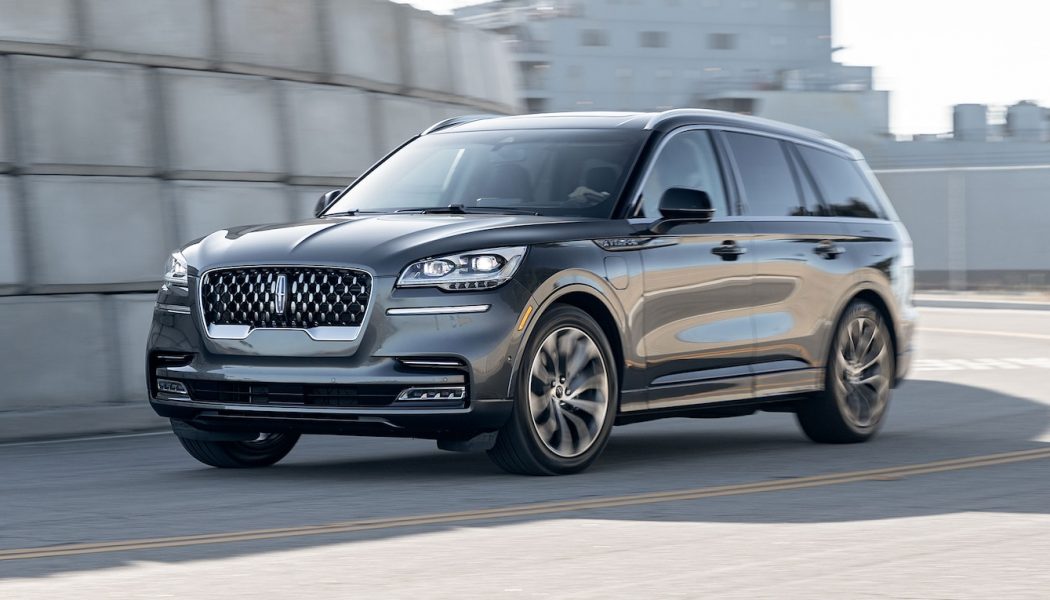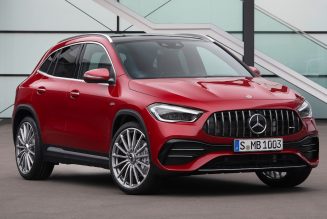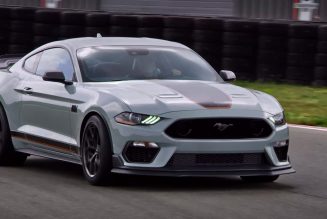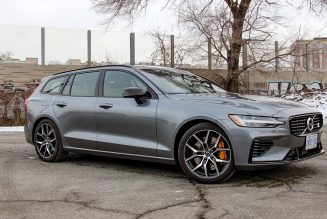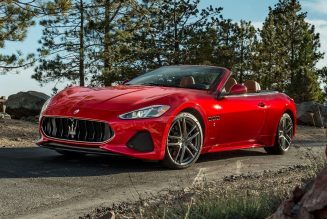Our $84,845 (as-tested) Aviator Grand Touring Reserve seems to tick all the boxes: a plug-in hybrid powertrain that delivers substantial power when asked and saves gas puttering around town, all packaged within the revitalized Lincoln interior design language that provides room for six.
How Does the Aviator Grand Touring Drive?
The Aviator’s 3.0-liter twin-turbo V-6, combined with the hybrid system’s 13.6-kWh battery and 75-kW motor, delivers 494 hp and 630 lb-ft of torque. As such, power delivery is strong and sure. This 5,700-pound beast delivers an estimated 0-60 time in the 5.5-second range.
That’s impressive, considering the Grand Touring weighs nearly 800 pounds more than a non-hybrid AWD Aviator. When you floor the accelerator in hybrid mode, you feel all the power of the combined units instantly, though you also feel the powertrain straining at the heft of the vehicle it is trying to motivate. Despite having nearly 500 hp on tap, the Aviator’s hybrid powertrain does not deliver the feeling of a Super SUV; it feels more like an electric boost of an overweight vehicle.
Switching to battery-only mode, the Aviator Grand Touring can send you about 21 miles before the gas engine takes over. And unlike some other hybrids’ “EV modes,” which kick in the gas engine at anything above running pace or if asked for full power, the Aviator’s battery-only mode can take you up to 80 mph with the full might of the battery pack. Once drained, the battery pack can gain some charge back via regeneration while you continue your journey under gas power.
The 10-speed automatic transmission’s shifts were relatively smooth whether gliding or hustling, and it felt more linear than, say, the rubber-band feel of the Lexus RX 450h’s CVT (though, to be fair, Lexus has done a good job refining the CVT). That said, coming away from a rolling “California” stop, the Aviator Grand Touring acted as if it didn’t know whether it wanted to do so under engine or battery-motor power or both—surging and jerking on repeated occasions. As this is the pace of parking lots and slow-and-go traffic jams, this dynamic has the potential to be a recurring irritability.
The Aviator Grand Touring’s adaptive “air-glide” suspension systems perform a good-enough job of soaking up road rash, but it does have a habit of hobby-horsing over undulations. A few passes through Palos Verdes’ notoriously topsy-turvy Portuguese Bend produced a neck-snapping oscillation in both Normal and Excite modes.
That leads to a discussion of the Aviator’s seat location, which feels as though you are “on” the car rather than nestled in it. This effect amplifies—at least to this 6-foot-1 male—the hobby-horsing sensation in your inner ear. Even though the air suspension combines with the battery pack’s lowering of the vehicle’s center of gravity to keep things pretty flat dynamically, as a tall driver, I had a distinct vestibular feedback of tippiness.
Steering feel is a bit loose on center, but with such a heavy vehicle, it’s probably better than something set with a snappy reactivity. Brake feedback and modulation was typical for hybrids with regenerative braking—a bit vague and spongy. Whichever automaker gets hybrid braking feel consistently right shall receive a blue ribbon.
How does it tow? When equipped with the optional Class IV tow package, the Lincoln Aviator Grand Touring delivers a maximum trailer capacity of 5,600 pounds. That’s a tandem-axle trailer carrying a Boston Whaler 210 Montauk or a couple of Jet Skis with little problem.
How Luxurious is the Aviator Grand Touring’s Interior?
Inside, the Aviator Grand Touring’s interior is elegant but not opulent. Based on the Aviator Reserve trim—itself one tier down from the opulent Black Label trim—it’s not quite as upscale as that of its sibling top-line Lincoln Navigator or Aviator Black Label (what is?), though it performs a decent approximation. More important, the Aviator’s insides certainly look and feel closer to those of a Navigator than to the down-market Ford Explorer ST, which shares the same platform. In addition to the cool midcentury modern styling and snazzy trim bits, another visible difference is the piano-key shifter, which is an appreciated design touch but takes some getting used to after decades of traditional PRNDL stalks.
The optional 30-way “perfect position” seats with massage function definitely reduce fatigue on long journeys. You will want to experiment with the seat’s maneuverability to find the perfect setting for you. As American luxury vehicle seats go, these seats are comfortable, but can they match Volvo’s world-class ass-huggers? Not quite, but close. These heated and ventilated seats are available either in the Luxury package ($3,300) or the larger Equipment Group 302A ($14,950). The latter package is primarily what jacked up our Aviator Grand Touring’s base price of $69,895.
Moving back a row, the second-row captain’s chairs have plenty of legroom but seem a bit skinny for how much space their footprint occupies in the cabin. That also seems to impact the third row, which has room only for children—odd because the platform-sharing Ford Explorer’s third row is relatively comfortable and spacious.
Audiophiles will rejoice at the top-notch Revel Ultima stereo, with 28 speakers and featuring QuantumLogic 3D Surround technology. And even though it’s powerful and clear, the Revel’s sound seems a little bit “bright,” no matter what type of music you are listening to or how you set it up.
How does the Aviator Grand Touring’s Hybrid System Work?
Let’s get to the tech: There’s the issue of actually “plugging in” the plug-in hybrid Aviator. I tried three random public electric vehicle charging stations in Los Angeles, and none of them had the common SAE J1772 Level 2 plug that would match the one in the Lincoln. Our testing director, Kim Reynolds, explains that most new charging stations are equipped only with EV-friendly Level 3 Combined Charging System (CCS) high-speed chargers, which the Aviator Grand Touring (like most plug-in hybrids) does not accept. So if you are out on the road and looking to recharge for some reason, you’ll need to find a Level 2 SAE-format charging system. I’d recommend firing up Google Maps on your phone and typing in “EV charging stations.” Doing so would have told me which stations were and weren’t compatible with the Aviator plug-in, as well as the availability of J1772 charge stalls. Yes, we’re still living in a world without an industry vehicle-charging standard.
What’s more, the 20-foot home-recharging cord Lincoln supplies is frustratingly short if you are like me and many other Americans and park in your driveway rather than your garage. Using an extension cord is a bad idea due to overheating concerns; you’ll need to buy a longer J1772 portable Level 1 charger or invest in installing a faster dedicated Level 2 home charging station. According to the EPA, the Aviator Grand Touring can recharge its battery from empty to full in about 3 1/2 hours on a 220V Level 2 charger. If you’re able to plug in to a standard 110V outlet using the Lincoln-supplied portable charger, a full charge will take about 12 hours, making overnight charging a feasible option for most commuters.
The battle with technology continued in other venues. While gently backing up in my driveway, the automatic emergency brake slammed the car to a halt because it confused a shadow for a solid object. Also, the button on the hatch lid that purportedly automatically closes the hatch and sets the alarm refused to function.
I also have gripes with poor user interfaces. For instance, the spoken-command button is located at 10 o’clock on the steering wheel—exactly where your left thumb will grip and depress every time you initiate a turn. So unless you change your (proper) hand positioning, every cornering maneuver gets interrupted by an automated audio prompt. In our SUV of the Year review of the Aviator, the MotorTrend judges were split on this feature, so some of you might love the convenience of not taking your hand off the wheel—but I despise it.
It wouldn’t be that bad if voice commands actually worked, but the Lincoln system is based on Ford’s Sync, which still struggles to provide a correct response to many questions or commands. Plugging in your iPhone or Android to take advantage of Apple CarPlay or Android Auto is unquestionably the best way to go.
The Lincoln Aviator GT features a Range Rover Sport-esque silhouette, snappy interior design, and laudatory dynamic performance. But there are some calibration issues with the hybrid powertrain, brakes, and telematics that lead us to suggest you should comparison shop to assess if this Lincoln is on par with its European and Japanese rivals to be sure.
| 2020 Lincoln Aviator AWD (Grand Touring PHEV) | |
| BASE PRICE | $69,895 |
| LAYOUT | Front-engine, AWD, 6-7-pass, 4-door SUV |
| ENGINE | 3.0L/400-hp/415-lb-ft twin-turbo DOHC 24-valve V-6, plus 100-hp/221-lb-ft elec motor, 494 hp/630 lb-ft combined |
| TRANSMISSION | 10-speed automatic |
| CURB WEIGHT | 5,700 lb (mfr) |
| WHEELBASE | 119.1 in |
| L x W x H | 199.3 x 79.6 x 69.6 in |
| 0-60 MPH | 5.4 sec (MT est) |
| EPA FUEL ECON | 22/25/23 mpg (gas); 54/58/56 mpg-e (gas+elec) |
| ENERGY CONSUMPTION, CITY/HWY | 62/58 kW-hrs/100 miles (gas+elec) |
| CO2 EMISSIONS, COMB | 0.35 lb/mile (gas+elec) |
| ON SALE | Currently |
